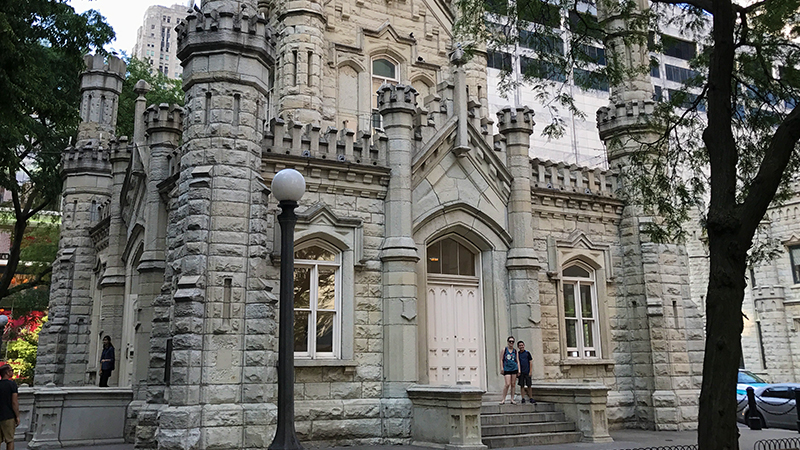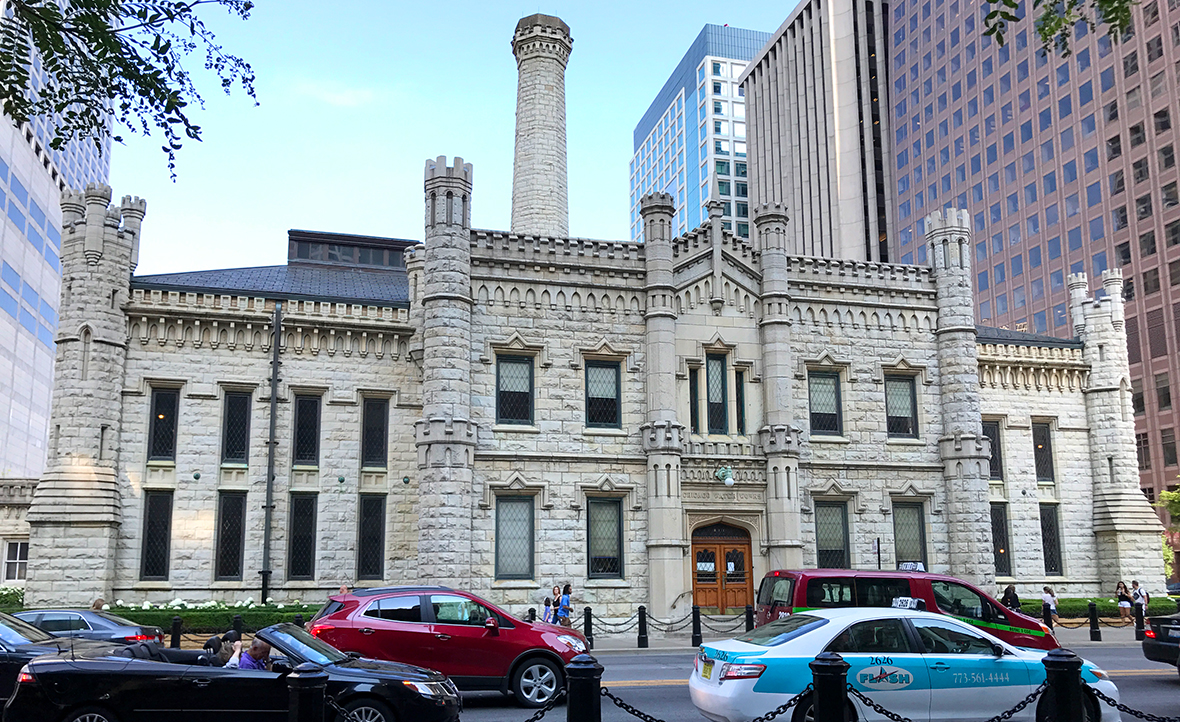
During multiple cab rides toward Chicago’s Lincoln Park area, we passed two beautiful, old buildings with Gothic architectural elements that resembled miniature medieval castles. Standing between enormous skyscrapers of glass and steel, they looked incredibly out of place and I knew I needed to get a closer look.
Luckily, we had no plans for our last day in Chicago. As with all of our vacations, we leave the last day open, with no plans, so we can relax. After a leisurely breakfast, we decided to ride the train again so Brian could visit the Chicago Music Exchange, and on the way back, depart the train near the Chicago River so we could walk around and explore the Riverwalk and the Magnificent Mile, and visit those two gorgeous buildings.
On our Architecture Boat Tour earlier in our visit, we learned that the buildings are the historic Chicago Water Tower and Chicago Avenue Pumping Station.

About The Chicago Water Tower And Chicago Avenue Pumping Station
According to the Chicago Tribune, Chicago’s drinking water in its early years was scandalously bad. The water, drawn mainly from the Chicago River, which was also the city’s sewer, at best tasted foul and at worst carried deadly diseases like cholera and typhoid fever.
The Chicago Water Tower and the Chicago Avenue Pumping Station are located in the Old Chicago Water Tower District landmark district. Both buildings were designed by William W. Boyington, one of Chicago’s most prolific architects of the mid-nineteenth century, and built with distinctive yellow Joliet limestone, a very popular building material in the city at the time. The Water Tower and Pumping Station showcase Boyington’s signature castellated Gothic Revival style and look like something out of a fairy tale.
Constructed between 1867 and 1869, the Water Tower was built to disguise a three foot wide, 138 foot tall iron standpipe that equalized pressure and minimized water pulsation in the mains.
- The foundation of the Chicago Water Tower is made up of 168 piles filled with concrete and capped with 12-inch oak timbers.
- Massive stones laid in cement make up the tower’s base.
- The net-gothic Water Tower facade rises in five sections from the square ground level base>,/li>
- Each of the 40 foot wide sides has a stately doorway and two grand windows.
- The octagonal tower rises 154 feet above the ground level
The Chicago Avenue Pumping Station has the capacity to pump 18 million gallons per day, which was actually 60% more than the city required at that time.
The pumping station remains in use by the Chicago Water District today, but the Water Tower outgrew its original function and in 1911, the standpipe was removed. The spiral staircase that wrapped the standpipe, however, is still intact. As one of the few buildings in the area to survive the Chicago Fire of 1871, the Water Tower became a symbol of hope and survival.
The Chicago Water Tower was designated the first American Water Landmark in 1969 and was designated a Chicago Landmark in 1971. The tower and pumping station were added to the National Register of Historic Places in 1975.
Go Inside The Water Tower And Pumping Works Building
When we visited the historic Water Tower, we did so only to admire it from the surrounding park area. We had no idea that you can go inside the water tower! When you step inside, you can see the original spiral staircase and visit the City Gallery, Chicago’s official photography gallery that showcases the work of local photographers and artists.
We also didn’t know that you can go inside the Chicago Water Works pumping station across the street! When we walked inside the old building, we were surprised to see a modern and active pumping station — it was really cool to get a small peek at how the water is pumped in the city. Next we walked around the outside of the building to admire the beautiful architecture, and came across Chicago Fire Department Station No. 98, the oldest fire house in the city of Chicago, located right next door.
“We know that the Water Tower and Pumping Station survived the Chicago Fire of 1871. But most do not know that they survived because of a German immigrant fireman, Frank Trautman. He covered the buildings with woolen blankets and discarded canvas sails and kept the covers soaked in lake water.”
— Maurice Champagne, CAF Docent Class of 2004
While Brian chatted with the on-duty firefighters, Natalie, Carter and I looked around the station, checked out the fire engine, and browsed through historic photographs.
Know Before You Go
- The Chicago Water Tower is located at 806 North Michigan Avenue, Chicago, Illinois 60611 in the the Jane M. Byrne Plaza along the Magnificent Mile.
- Admission is free.
- Open daily from 10:00 am to 6:30 pm. Open on holidays from 10:00 am to 4:00 pm.
- Look out! Some say the water tower is haunted by the ghost of a worker who stayed to man the pumps as fire ripped through the city. When he realized that he couldn’t escape, he hanged himself in the tower.
- The Chicago Avenue Pumping Station is located across the street at 821 North Michigan Avenue, Chicago, Illinois 60611.









